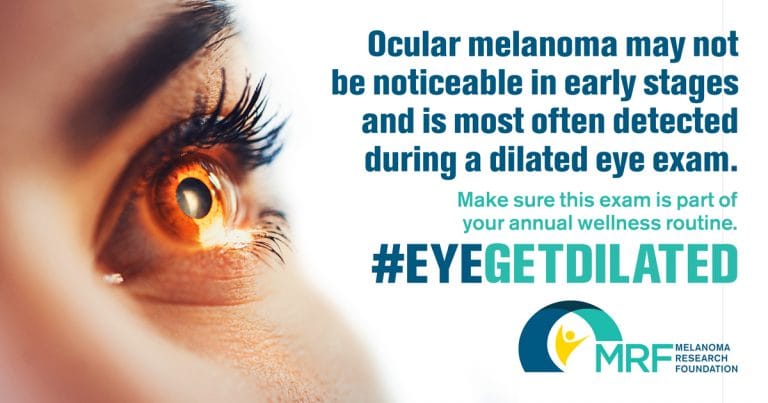January 27, 2025
Diagnosis (Ocular)
How is Ocular Melanoma Diagnosed?
Ocular melanoma (OM) is most often detected by an optometrist or an ophthalmologist during a dilated eye exam. Often, OM is asymptomatic until the tumor grows large enough to create visual disturbances. Only OM of the iris can be diagnosed by external – from the outside – examination.
After an OM diagnosis, your doctor may want to take an X-ray, MRI or CT scan of the body to check the body for signs of cancer beyond the eye.
Unlike other forms of melanoma, a biopsy is not usually taken to diagnose OM. Rather, OM tends to be a clinical diagnosis – meaning it is often made based on signs and symptoms.
If you or a loved one have been diagnosed with OM, or to learn more about OM research, treatment and support resources, please visit the MRF’s CURE Ocular Melanoma (CURE OM) initiative.

Introducing the New Ocular Melanoma Patient Guide!
Genetic Testing, Tumor Size and Metastatic Risk
Once ocular melanoma is diagnosed, several items should be discussed with your treatment team that will help everyone learn more about your specific diagnosis. While treating the primary eye tumor remains the most important clinical issue, determining a patient’s risk for developing metastatic disease is also important.
The American Joint Committee on Cancer (AJCC)
The AJCC Cancer Staging Manual is a resource that can help guide your treatment team in assessing the extent of the tumor, lymph node involvement and distant metastasis. This classification system organizes these individual factors into prognostic stages. Each stage indicates different risk for possible metastasis and mortality.
Common Genetic Tests in OM
Healthcare providers can determine a patient’s risk for metastatic disease based upon the size and location of the tumor. From a biopsy, they can also test the genes in the tumor itself to help determine the risk of cancer recurrence and metastasis. The results of these tests can help your treatment team develop an appropriate and individualized surveillance plan and, if necessary, a treatment plan.
Timing is critical because:
- These genetic tests come from a biopsy of the tumor.
- The biopsy must be taken before the tumor is treated with radiation.
Two different types of genetic testing may be performed:
1) CHROMOSOME ANALYSIS (KAROTYPING)
Abnormalities in chromosomes 1,3,6 and 8 may indicate an increased risk of uveal melanoma metastasis. About half of UM tumors will show an alteration of chromosome 3 and metastatic UM occurs almost exclusively in patients with a loss of chromosome 3 (monosomy 3).
2) GENETIC EXPRESSION PROFILE (GEP) TESTING
This test measures the gene expression profile (GEP), or molecular signature, of the tumor. It is based on a 15-GEP test and groups the tumor into low-, medium- or high-risk for metastases over the next five years.
- Class 1A tumors have a very low risk of metastasis
- Class 1B tumors have an intermediate risk of metastasis
- Class 2 tumors have a high risk of metastasis
Should I have my tumor tested?
Studies have shown that, if given the opportunity, most patients prefer to know their risk. Patients often feel that they can make more informed decisions and have reported that knowing the results of the genetic test were valuable regardless of the results. Ultimately, the hope with genetic testing is that individual clinical follow-up can be tailored to a patient’s risk of metastasis and, perhaps, lead to earlier detection and therapy.
As with any genetic testing, this is a personal decision and many factors must be considered. Speak with your doctor about how long it will take to find out the results and whether or not insurance will cover the cost of the test(s). Speaking with a certified genetic counselor may also be helpful.
Tumor Size
The size of the eye tumor may also impact the prognosis and risk of metastasis. For example, a large tumor has a higher risk of spreading than a small tumor.
- Small: 1.0-2.5mm in height; greater than 5mm at the base
- Medium: 2.5-10mm in height; less than or equal to 16mm at the base
- Large: greater than 10mm in height; greater than 16mm at the base
Genetic Mutations in Ocular Melanoma
Although there are currently no therapies approved by the FDA for the treatment of metastatic OM, several are being studied in clinical trials. Therefore, knowing your mutation status may be helpful. A variety of genetic mutations have been found in OM. These mutations are thought to “drive” the disease:
- GNAQ and GNA11 – The GNAQ and GNA11 mutations are the most common mutations in uveal melanoma, appearing in more than 80% of all cases. These mutations do not seem to be associated with patient outcomes or risk of metastasis.
- BAP1 – The BAP1 mutation is found in about half of uveal melanoma cases. It is most often associated with older patient age and high risk for metastasis. The BAP1 mutation is strongly associated with a Class 2 gene expression profile (GEP).
- BRAF – The BRAF mutation is common in cutaneous melanoma but is rare in uveal melanoma. It is found in about 30% of conjunctival melanoma cases.
Speak with your oncologist about what your mutation status could mean and when your tumor should be tested.
What does this mean for treatment?
Currently, this does not impact treatment for primary OM. These results may impact surveillance and/or adjuvant therapy available in clinical trials.



